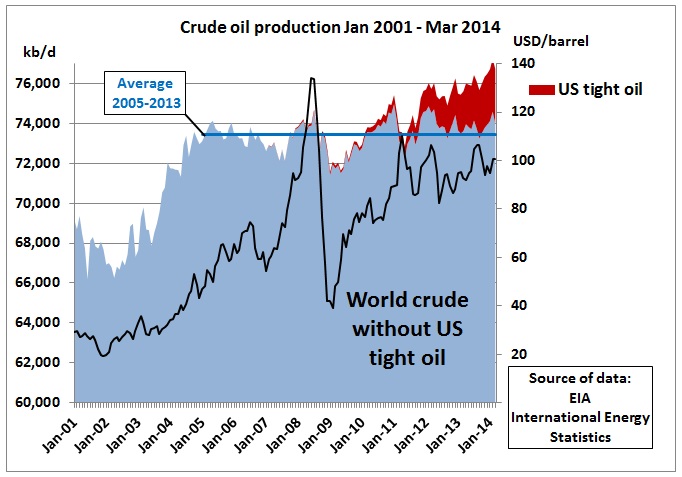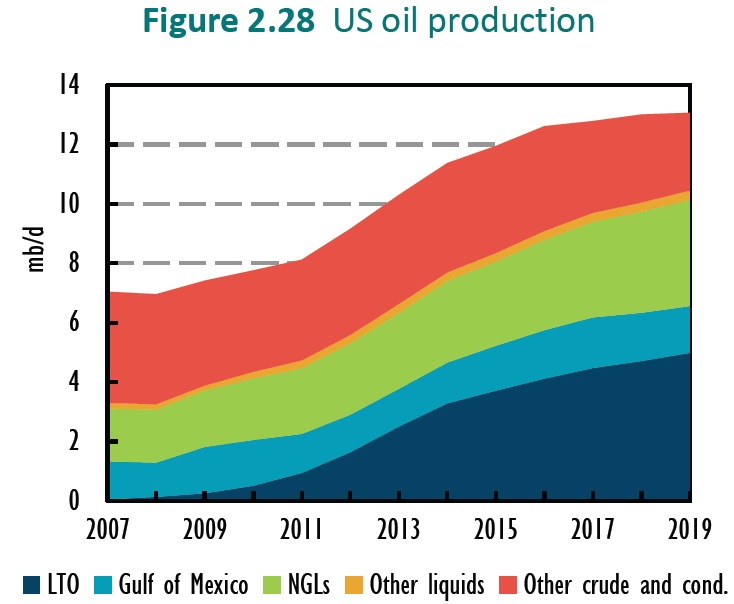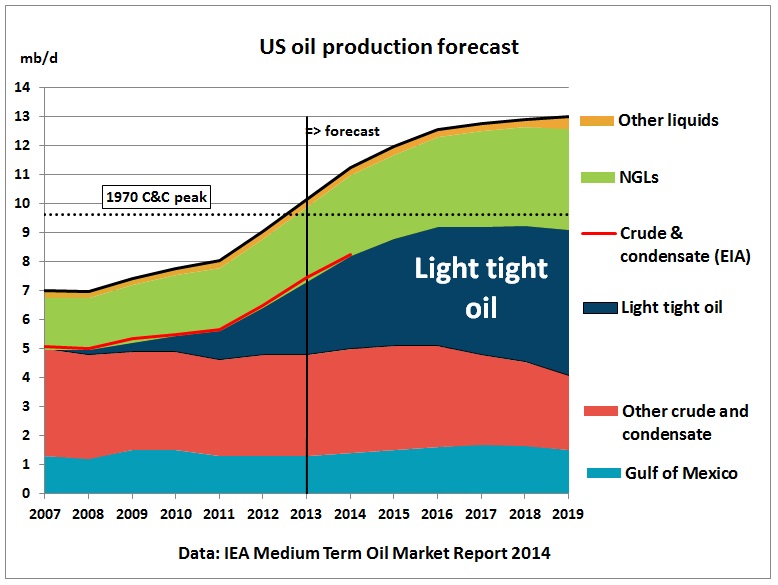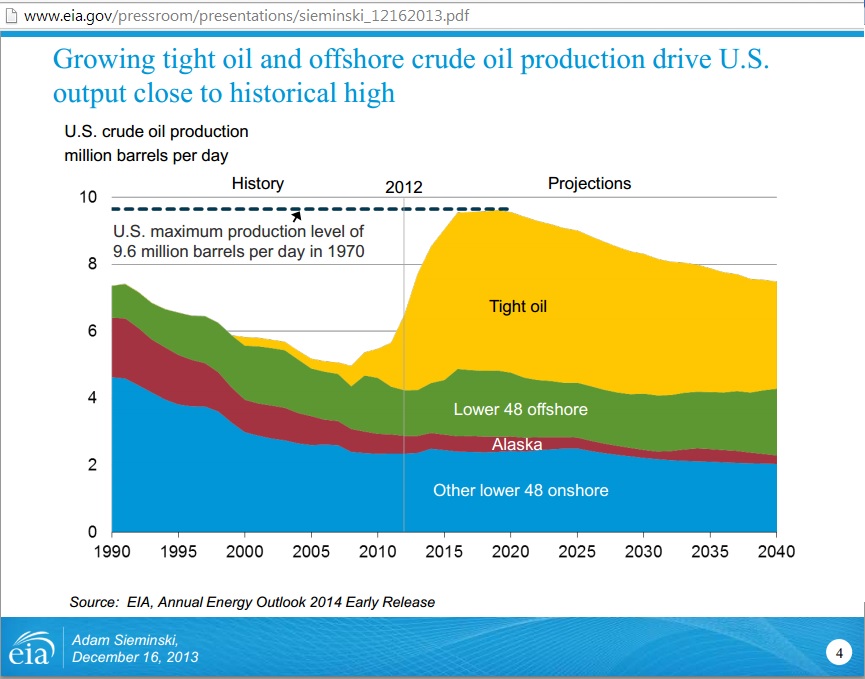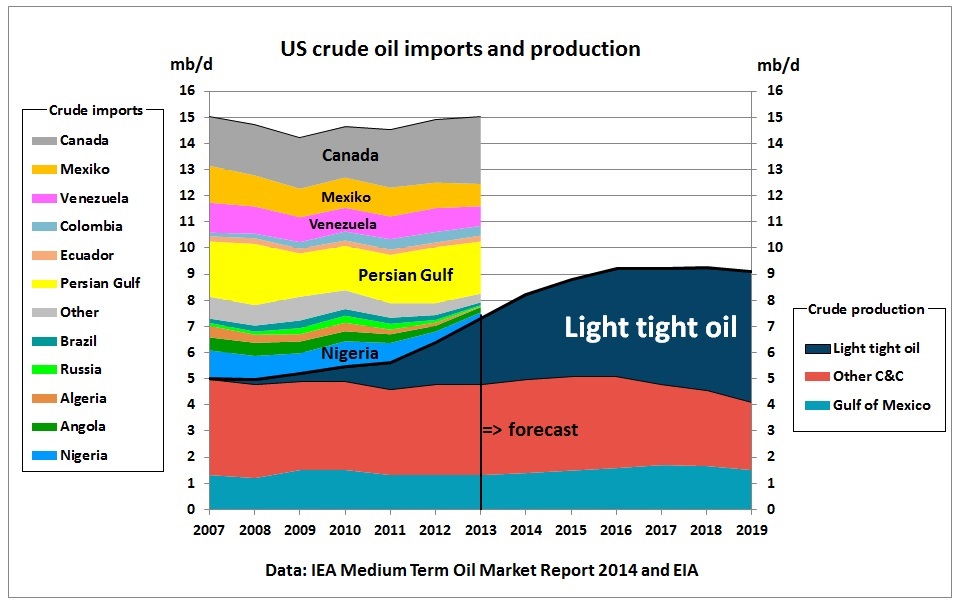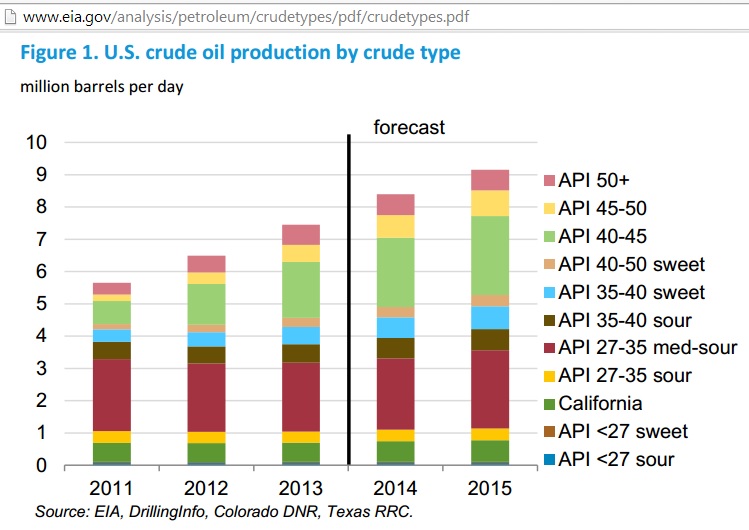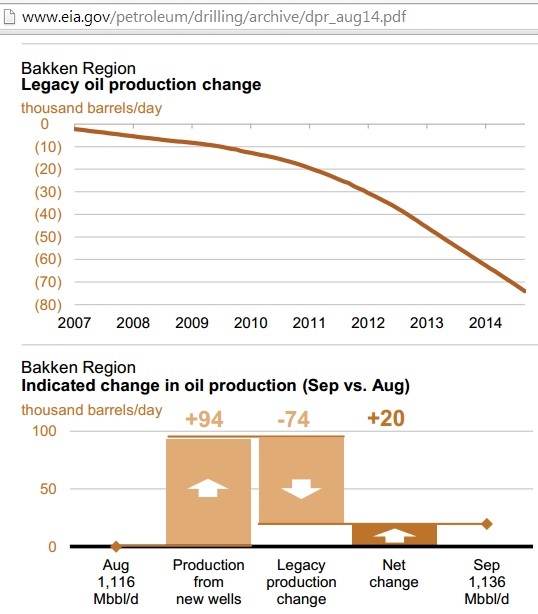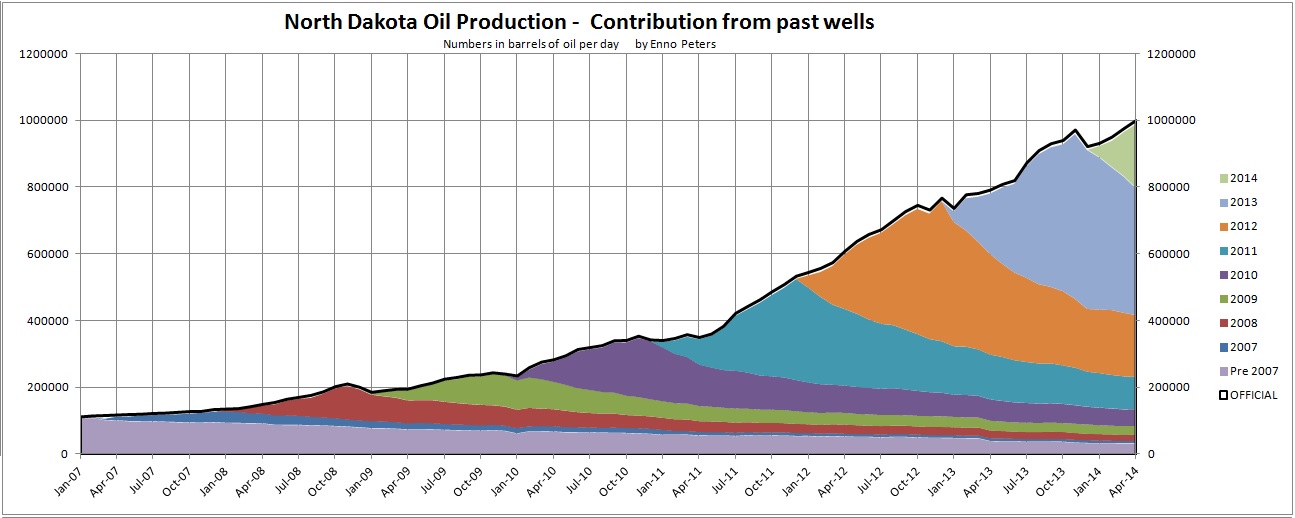The Medium Term Oil Market Report of the International Energy Agency (IEA, Paris), published in June 2014, contains a graph which implies that US crude production will start to peak in 2016. Few took notice although the world is continuously occupied with oil and energy related conflicts and wars in Ukraine, Libya and Iraq. So far, oil prices increased only shortly when fights flared up. Apparently oil markets are at ease while the US tight oil “revolution” is underway. But for how long?
Global situation
Fig 1: US tight oil and crude oil in rest of world vs oil prices
The graph shows that US tight (shale) oil sits on top of a bumpy crude production plateau in the rest of the world which clearly started in 2005 (average of 73.4 mb/d since Jan 2005). Despite increasing tight oil production oil prices did not go down but stayed at a level of around US$ 100 a barrel. We can safely say that without US tight oil – in May 2014 around 2.9 mb/d – the world would be in a deep oil crisis. People got accustomed to a higher oil consumption level which will be hard to come down from. Between 2005 and 2007, oil production declined by around 2 mb/d (supply shock) and oil prices doubled. That gives us an idea what will happen when tight oil starts to decline. So it is important to know when tight oil reaches its tipping point.
When will the US reach its 2nd (and last) crude oil peak?
The IEA’s Medium Term Oil Market Report contains following US oil production profile for the US:
Fig 2: US oil production approaching a peak at the end of the decade
http://www.iea.org/w/bookshop/464-Medium-Term_Oil_Market_Report_2014
Fig 2 shows US oil production approaching a peak by the end of this decade. Note that “oil” includes natural gas liquids (NGLs) which are not as versatile as crude oil which is the most important refinery feedstock to produce gasoline, diesel and jet-fuel. In the graph, NGLs are sandwiched between layers of crude oil thereby obscuring what is happening to crude oil alone. So Fig 2.28 needs to be re-stacked:
Fig 3: Restacked Fig 2.28
Conventional oil (blue and red areas), basically flat since 2011, will start to decline in 2016. Growing light tight oil, much of which is actually condensate (the reason for the tanker train fires), offsets this decline and keeps crude oil at 9.2 mb/d for the 2nd part of this decade, almost at 1970 peak levels (9.6 mb/d). In order to check the numbers the red line uses EIA data which match those from the IEA.
The green area is natural gas liquids (ethane, propane, butane, natural gasoline) coming from both oil and gas fields. They are not as versatile as crude oil. More, recent details on NGLs can be found in this article: http://www.eia.gov/todayinenergy/detail.cfm?id=16191
In December 2013, the Energy Information Administration published a similar crude graph with a peak plateau reached in the 2nd half of this decade.
Fig 4: EIA graph from the Annual Energy Outlook 2014 showing US production profile
http://www.eia.gov/pressroom/presentations/sieminski_12162013.pdf
The question of course is whether tight oil decline rates – for 2 decades – will be as moderate as depicted in this graph.
US crude production (May 2014 data)
Fig 5: US crude production by area
Data are from here: http://www.eia.gov/dnav/pet/pet_crd_crpdn_adc_mbbl_m.htm
Please note that EIA’s recent tight oil production data are estimates starting in June 2013, assuming that Texas production increased by 44 kb/d per month, giving a linear growth. It is not clear how these preliminary statistics will be corrected in future.
Does EIA Drilling Productivity Report Reflect Real World?
1/4/2014
“Every month showed a projected output increase. Given what we knew about the production output during the winter months obtained directly from the North Dakota Department of Mineral Resources (DMR) that showed a significant drop in production, and especially Bakken output, which is what dominates the state’s oil production, we wondered about the EIA’s forecasts.”
Impact on US crude imports
We stack US crude oil import data on the crude oil production curve.
Fig 6: US crude imports stacked on crude production
Data from http://www.eia.gov/dnav/pet/pet_move_impcus_a2_nus_epc0_im0_mbblpd_a.htm
Fig 6 shows that the tight oil wedge allowed the US to reduce crude imports from Nigeria, Angola, Algeria, Russia, Brazil and many smaller exporters. Imports from the neighbouring countries Canada, Mexico, Venezuela, Colombia and Ecuador remained unchanged at around 4.8 mb/d whereby growth from Canada offset decline in Mexico.
Most notably, imports from the Persian Gulf have hardly changed in 7 years, mainly impacted by the financial crisis in 2009, with a slow recovery.
Fig 7: US crude imports from Persian Gulf countries
US light tight oil (with a high percentage of condensate) is not necessarily a replacement for all types of crude imports which must match US refinery requirements traditionally geared for heavier crude oil. Fig 6 suggests there will be problems in the next years how to accommodate 1 – 1.5 mb/d of tight oil as already discussed in the following article:
Absorbing Increases in U.S. Crude Oil Production
1/5/2013
Fig 8: US Gulf coast crude imports by typ
http://www.eia.gov/oog/info/twip/twiparch/2013/130501/twipprint.html
An update of this analysis can be found in:
U.S. Crude oil production forecast
Analysis of crude types
29/5/2014
Fig 9: US crude oil production by crude type. Condensate has API >47
http://www.eia.gov/analysis/petroleum/crudetypes/pdf/crudetypes.pdf
In any case, gross US refinery inputs must be maintained at around 15 mb/d which is the long term level as can be seen in this EIA graph:
Fig 10: US gross inputs to refineries
http://www.eia.gov/dnav/pet/hist/LeafHandler.ashx?n=pet&s=mgirius2&f=a
US crude exports
There is a ban on exporting US crude oil since 1970, the 1st US oil peak. Exports to Canada are usually allowed as fuels refined in Canada would flow back into the US.
In 2013 crude exports to Canada were 120 kb/d but increased to 288 kb/d in May 2014
http://www.eia.gov/dnav/pet/pet_move_expc_a_EPC0_EEX_mbblpd_m.htm
Light tight oil is used in Canada as a diluent for bitumen from tar sands.
Mechanics of tight oil decline
The situation is best described in the EIA drilling productivity reports. Taking the example of Bakken in August 2014, net production growth of 20 kb/d per month is the result of new wells production of +94 kb/d minus a decline in old wells of 74 kb/d.
Fig 11: Bakken growth and decline
http://www.eia.gov/petroleum/drilling/archive/dpr_aug14.pdf
In order to appreciate the enormous drilling effort of 94 kb/d x 12 months = 1.1 mb/d pa with a very modest net result of 240 kb/d pa let us compare that with Iran’s oil boom year 1972/73 in which oil production (in conventional fields) increased by 850 kb/d pa.
Systems in which net results are the difference between 2 high numbers are numerically very sensitive to changes of parameters and assumptions.
Fig 12: Bakken trend lines of growth and decline
Using drilling productivity reports from Oct 2013 to Aug 2014, we see that both monthly growth and decline rates have been growing, but at a different pace. Decline is growing faster than new capacity can be added. Therefore there will be a point were trends intersect and net growth will be zero, some time by mid 2016, incidentally. After that, things will become very frustrating. The drilling effort will have to be maintained but net decline sets in.
As EIA’s estimates go back almost one year the inflection point may not be discovered statistically until after it has happened. We can expect a loss of the public’s confidence in the rosy energy revolution predictions of the oil and gas industry
An analysis of all tight oil fields in the US goes beyond the scope of this article. A website which monitors tight oil in the US in more detail is http://peakoilbarrel.com/
Fig 13: North Dakota production profile by year of wells
http://peakoilbarrel.com/bakken-update-february-production-numbers/
What Fig 13 shows: the more wells are added, the steeper future decline rates of the whole system.
How the peaking of US tight oil production will impact on the ability to finance drilling when the end result is decline is yet unknown. What is known, however, is that oil companies are already struggling now, as described in this EIA article:
As cash flow flattens, major energy companies increase debt, sell assets
29/7/2014
Fig 14: Major Energy Companies’ cash from operations and use of cash
“Based on data compiled from quarterly reports, for the year ending March 31, 2014, cash from operations for 127 major oil and natural gas companies totaled $568 billion, and major uses of cash totaled $677 billion, a difference of almost $110 billion. This shortfall was filled through a $106 billion net increase in debt and $73 billion from sales of assets, which increased the overall cash balance”
http://www.eia.gov/todayinenergy/detail.cfm?id=17311
For argument sake, in the next credit crunch finance for those expensive tight oil wells may dry up, resulting in an immediate drop of production.
Clearly, the world relies on a dangerous drug called tight oil.
Conclusion:
Assuming current US refinery inputs remain at around 15 mb/d the US will always need to import around 6 mb/d of crude oil, 80% of which comes from neighbouring countries. Apart from high decline rates, tight oil production may also be limited by how these light oils and condensates can be accommodated by US refineries.
When it becomes apparent that US tight (shale) oil has peaked, there will be a public confidence crisis because the media are parroting the oil and gas industry’s claim that shale oil is an energy revolution and game changer. Indeed, the game will change, but in unexpected ways.
